He came to Buffalo a relative unknown.
When Ralph Krueger was hired as head coach of the Buffalo Sabres, he was not considered a slam-dunk candidate. Not having coached in the National Hockey League since 2013, the former chairman of the Southampton Football Club entered Buffalo incognito to learn and explore.
The anonymity did not last long. After so many years of terrible hockey in Western New York, the Sabres started off 8-1-1 and the new coach could not peruse the local watering holes as freely as before.
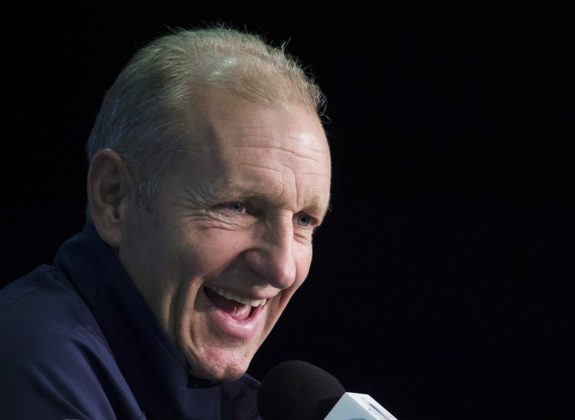
The month of November was not a banner month for the Sabres. They came back down to Earth but managed to escape the month in the hunt for a wildcard spot. Krueger has taken the challenge he has been presented with and managed to squeeze results from a fruit that appeared less ripe just a few weeks ago.
Krueger Getting the Most Out of an Imbalanced Roster
General manager Jason Botterill has made himself busy overhauling the defence since last February, adding the likes of Brandon Montour, Colin Miller and Henri Jokiharju. The roster now has seven defencemen with Rasmus Dahlin on injured reserve and Matt Hunwick on long-term injured reserve.
At the American Hockey League level, the Rochester Americans have Lawrence Pilut, Will Borgen, Casey Nelson and John Gilmour. Each of these young men has played at the NHL level and is capable of filling in if need be. Pilut should arguably be playing a full-time role with the Sabres.
In total, the Sabres organization currently has upwards of 13 defencemen available for six positions. There is an obvious imbalance that must be fixed. Speculation was rampant over the summer that Rasmus Ristolainen was made available for trade. This season, rumours have swirled that the Sabres are searching for forward help.
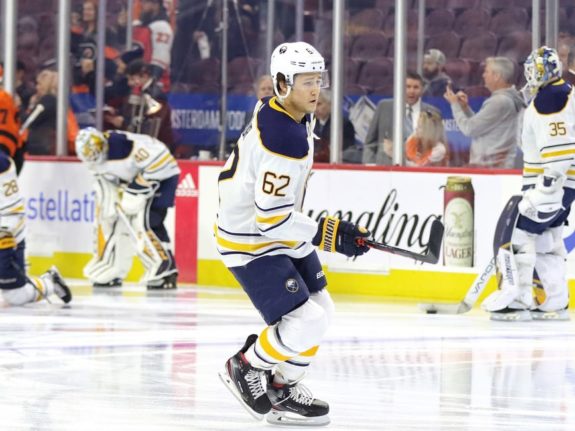
Yet, we’re now in December and here we sit. The hoarding of defencemen has worked to a degree. The Sabres are in the top-10 of the league in goals allowed with 82. According to Evolving Hockey, they rank 12th in the league in expected goals against per 60 minutes (xGA/60) at five-on-five with 2.28. The goaltending has been average and the defence has limited chances against. All is according to plan.
Offensively, the Sabres rank 17th in the league in goal-scoring with 84 goals. What’s more alarming is the fact that they rank 26th in five-on-five expected goals for per 60 minutes (xGF/60) with just 2.12. To this point, they have been able to catch some questionable goaltending and shoot at a higher rate than expected, helping them exceed their expected offensive output.
As injuries began to mount up front, Krueger was presented with a challenge: how was he going to dress a competent NHL lineup every night?
Krueger’s Lineup Decisions Paying Off
Conventional wisdom dictates that you should dress 12 forwards and six defencemen each night. What has been interesting is seeing how Krueger has bucked this trend so far this season.
The Americans have been able to provide assistance upfront thus far. Rasmus Asplund, Curtis Lazar and Jean-Sebastien Dea have filled in when called upon. It’s been a challenge to rely on help from the Americans, however. Experiencing a number of injuries themselves, it has been a balancing act to supply the Sabres with enough bodies while not crippling a successful program in Rochester.
How has Krueger tackled the problem? By playing 11 forwards and seven defencemen. This strategy has worked on so many levels for the Sabres so far this season.
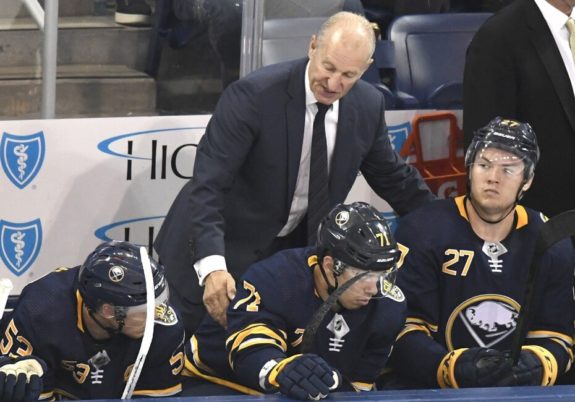
As mentioned, the Sabres have a significant lack of depth in the forward ranks. As such, they are seeing their skill dry up precipitously the further down the lineup you look. Most would simply try to add another forward from the AHL to fill in a depth spot. Such a move would have only minimal impact on this roster as currently constructed.
Adding a minor league player to a line featuring players who aren’t scoring in the NHL will hardly make a dent on the scoresheet. What Krueger has done is deploy Zemgus Girgensons and Asplund with a rotating forward. Such a move gives him full control over the pace and punch that his team will play with. Whoever is rolling on any given night can be rewarded with additional ice time.
Jack Eichel has been on a roll this season. Being able to double-shift him adds a new wrinkle to the offence and gives opposing coaches and defenders something different to deal with. Adding speedy waterbug Conor Sheary or a sniping net-front presence in Jimmy Vesey to the line gives such a variety of different looks that can keep the opposition on its toes.
Krueger’s Decisions Felt Throughout The Lineup
The residual effects of such a lineup decision go beyond the forwards. Initially, a different defenceman was being deployed with the fourth forward unit. While this was ok, it didn’t have the full desired effect.
Instead, all seven defencemen have been active in the lineup. Krueger explained in his weekly segment on WGR550 in Buffalo that each defenceman has two different partners that he could skate with at any given time. Such an assortment of looks in their own zone has been a positive for the Sabres thus far.
Another residual effect has been a levelling in the distribution of ice time for the defenders. With seven mouths to feed every night, no one defenceman can receive a significant portion of time in play. In Monday’s game against the New Jersey Devils, for example, Zach Bogosian led the defence in ice time with just 18:57.
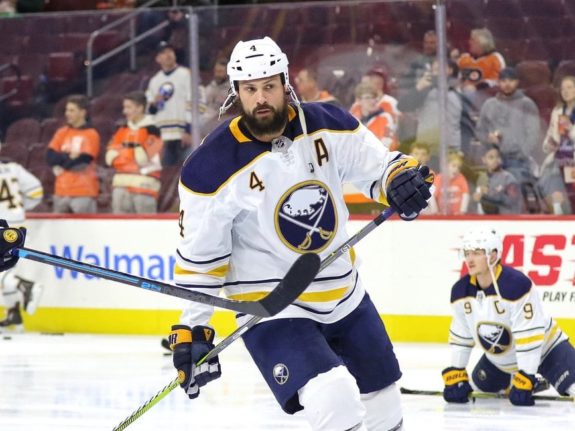
Ristolainen, in particular, has seen a significant drop in his deployment. This drop corresponds with a seeming increase in the quality of play for the hulking blueliner. On the season, Ristolainen averages over 17 minutes of five-on-five time each night and sports a 47.35xGF%. Over the past two weeks, Ristolainen has seen his ice time drop below 15 minutes five-on-five per game but at the same time has had his xGF% to 52.91xGF%.
The cries and pleads of Sabres fans have finally been heard. Over the past few seasons, it’s become apparent that Ristolainen has not been used properly and needed to be on the ice less. Due to circumstances, he was often been required to play big minutes, regularly in his own zone.
Krueger is the first coach in Ristolainen’s career that has been able to use him properly. What he has been doing so far is working. Keeping Ristolainen on this path, especially while Dahlin is out, can help him to get his career back on track and perhaps build his trade value.
Botterill Needs to Reward Solid Play
Krueger has done exceptionally well given the roster he currently has. Things are very similar in the lineup to what we saw last season. The results, however, have been different so far. Krueger is implementing his offence as best as he can, even making the unpopular decision to split up Jeff Skinner and Eichel.
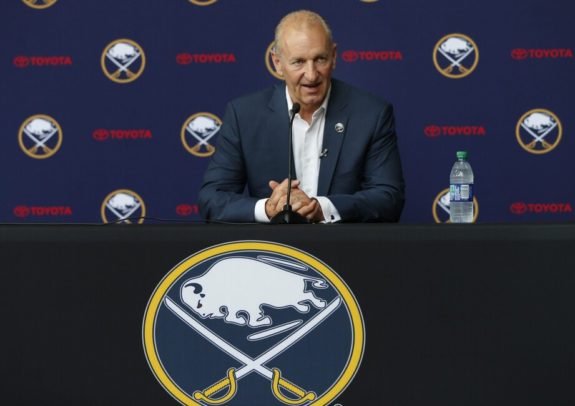
Eventually, Botterill will be forced to give Krueger something more to use in the forward ranks. To this point, there have been “timely” injuries on the backend that have allowed the roster to continue as is. As early as next week, Dahlin could be back in the fold and the team will once again be equipped with eight defencemen. The way the team has played the last couple weeks coupled with the patience of an aggravated fanbase should dictate that Botterill needs to reward all those who care about the blue and gold.
In seasons past, the system the team played was flawed and merely adding players would not have the desired effect. Krueger’s system is really beginning to take effect, with nine of the last 11 games being over 50xGF% at five-on-five with score effects. He is developing a means to success based on how this roster is constructed. How far can he guide the Sabres this season? Like Krueger initially, that remains another unknown.